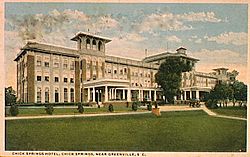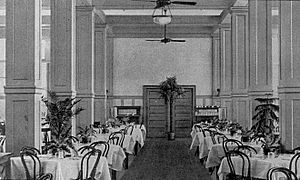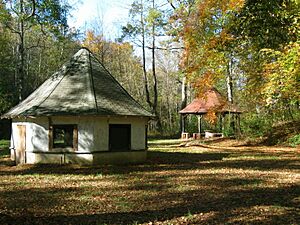Chick Springs facts for kids
Quick facts for kids
Chick Springs,
|
|
|---|---|
|
Mineral springs
|
|

The final Chick Springs Hotel, around 1914.
|
|
| Country | United States |
| State | South Carolina |
| County | Greenville |
Chick Springs is a special place in Taylors, Greenville County, South Carolina. It's known for its natural mineral springs. For many years, from the mid-1800s to the early 1900s, it was a popular resort community. People came from all over to visit the springs.
Contents
The Special Water
Native Americans living near the Enoree River knew about the healing power of these mineral waters. Early European visitors also noticed them. In 1826, an architect named Robert Mills described the water. He said it was perfectly clear but smelled strongly, "like the washings of a gun barrel." He believed it helped cure skin problems like ringworm.
A Resort Begins
In 1840, a man named Burwell Chick opened a resort at the springs. He built a large hotel and allowed small "cottages" to be built nearby. After he passed away in 1847, his sons, Pettus and Reuben, continued the business.
By the 1850s, a railroad reached the area. This made it easier for people to visit. The resort became very popular, attracting hundreds of guests at a time. It also helped the local economy. Farmers from miles around could sell their crops and animals to the resort.
Fun at the Resort
Visitors to Chick Springs found many ways to have fun. One reporter in 1854 described a busy scene. People played card games like whist on the porches. Inside, two pianos played music, and people sang along. There was also a billiard table and a nine-pin alley for bowling.
Many guests walked to the spring house to drink the sulphur and chalybeate (iron-rich) water. Some played quoits for exercise. The reporter also mentioned fresh watermelon and evening dances that lasted until midnight. It was a lively place!
Changes and Rebuilding
The Chick brothers sold the property in 1857. A few years later, on November 4, 1862, the hotel caught fire and burned down. In 1868, the Chick family bought the property back. Then, in 1885, they sold it to George Westmoreland, a lawyer from Atlanta. He built a new hotel and several cottages.
In 1903, Westmoreland sold the property to James A. Bull. Bull was a successful grocer and businessman from Greenville. He made the hotel much bigger. In 1905, he had 4,000 guests between May and October.
Modern Amenities and Activities
Bull's resort covered 117 acres. It had pavilions, croquet grounds, tennis courts, and golf links. Guests could enjoy bowling, archery, target shooting, swimming, and horseback riding. The hotel was modern for its time. It had telegraph and long-distance telephone lines. Guests could even buy New York and Washington newspapers on the same day they were published. Bull also bottled the spring water to sell.
The Final Years
In December 1907, Bull's hotel also burned down. Luckily, Bull had his own firefighting equipment. He saved most of the other buildings and cottages. In 1914, Bull finished building an even larger hotel. It cost $100,000 and was made of Spanish-style architecture. It was three stories tall, fireproof, and had all the latest features.
However, Bull's business didn't do well. From 1916 to 1917, the property was used as a military academy. After that, Bull tried to combine the hotel with a sanatorium (a type of hospital for long-term care). This venture closed shortly after Dr. Benjamin Broadus Steedly, who ran it, passed away in 1932.
Bottling the mineral water remained profitable. In 1927, the Chick Springs Ginger Ale Company was started. They made carbonated drinks. The company also built a swimming pool and opened a park. The park had picnic areas and a large dance floor. But this business also failed during the Great Depression. The land around the spring went back to the Bull family.
Chick Springs Today
By the 21st century, only the spring house and a picnic gazebo remained from the old resort. In 2008, a group called the Chick Springs Historical Society was formed. Their goal is to buy and protect the seven-acre site around the springs as a park.



